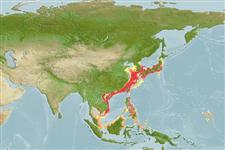>
Eupercaria/misc (Various families in series Eupercaria) >
Latilidae (Deepwater tilefishes)
Etymology: Branchiostegus: Greek, brangchia = gills + Greek, stego = roof, to cover (Ref. 45335).
Environment: milieu / climate zone / depth range / distribution range
Ecologia
marino benthopelagico; distribuzione batimetrica 30 - 100 m (Ref. 11230). Temperate
Northwest Pacific: southern Japan and East China Sea.
Size / Peso / Age
Maturity: Lm ? range ? - ? cm
Max length : 45.0 cm TL maschio/sesso non determinato; (Ref. 9137)
Inhabits sandy and muddy areas (Ref. 9137, 11230).
Life cycle and mating behavior
Maturità | Riproduzione | Deposizione | Uova | Fecundity | Larve
Dooley, J.K., 1978. Systematics and biology of the tilefishes (Perciformes: Branchiostegidae and Malacanthidae) with descriptions of two new species. NOAA Tech. Rep. NMFS Circ. No. 411:1-78. (Ref. 8991)
IUCN Red List Status (Ref. 130435: Version 2024-1)
Threat to humans
Harmless
Human uses
Pesca: commerciale
Strumenti
Special reports
Download XML
Fonti Internet
Estimates based on models
Preferred temperature (Ref.
123201): 16.5 - 24, mean 22 °C (based on 56 cells).
Phylogenetic diversity index (Ref.
82804): PD
50 = 0.5000 [Uniqueness, from 0.5 = low to 2.0 = high].
Bayesian length-weight: a=0.00708 (0.00294 - 0.01707), b=3.07 (2.86 - 3.28), in cm total length, based on LWR estimates for this (Sub)family-body shape (Ref.
93245).
Trophic level (Ref.
69278): 3.4 ±0.45 se; based on food items.
Resilienza (Ref.
120179): Medio, tempo minimo di raddoppiamento della popolazione 1.4 - 4.4 anni (Preliminary K or Fecundity.).
Fishing Vulnerability (Ref.
59153): Low to moderate vulnerability (35 of 100).
